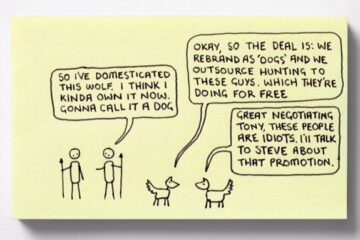After I published my recent book (get a free copy here), some people asked whether it was really possible for businesses to double profits in just a few months.
The answer is yes.
Let me show you how. Let me show how these gains come from applying just 3 simple principles – three principles that either work for your business, or against it.
And, when your business goes from being the victim of these principles, to benefitting from them, you can multiply your profits.
Principle #1: The Pareto Principle AKA the 80-20 Rule
The Pareto principle tells us approximately 20 percent of people control about 80 percent of the wealth.
Or, in business, 20% of companies control 80% of the market.
In the case of Adwords, the 3 ads at the top left get 10-20 times the click rate of the ads on the right hand side.
If we take the mid-point (15 times), that gives us:
3 ads at the top left with 15 times the click rate = 45 clicks
8 ads on the right with 1 times the click rate = 8 clicks
So the “Adwords Pareto” means 3/11 ads get 45/53 of the clicks.
Or, as a percentage, 27% of advertisers on page 1 get 85% of the traffic.
Not exactly 80-20, but close enough.
Why This Matters
By “jumping the gap” from 4th position (top ad on the right) to 3rd position (bottom ad on the left), you join the ranks of the “haves”, rather than “have nots” – and get 10+ times as much traffic… all for improving by just one position.
It’s this kind of improvement – growth measured in hundreds of percent, rather than a few percent – that my book is all about.
It’s about understanding what are the “big levers” you can pull that’ll double or quadruple your business in a short time.
Let’s move on to the second profit multiplier.
Principle #2: The Power of Compounding
Albert Einstein said, ‘Compound interest is the eighth wonder of the world. He who understands it, earns it … he who doesn’t … pays it.’
My ‘Adwords Multiplier Method’ harnesses the power of compounding by working on the following 5 things at the same time:
1. Number of ad impressions
2. Click rate
3. Conversion rate
4. Profit Per Sale
5. Purchases per client
If you can increase all 5 of these by just 15%, you double your income.
15%. That’s all.
Increase them by 30% and you’ll quadruple your sales. And, as you’re about to see, quadrupling your sales will do extraordinary things to your profits…
That leads us to the 3rd principle of profit multiplication…
Principle #3: It’s not how much you make, it’s how much you keep
I published a case study of how I increased the profits of an 8 year old PPC account by 643% in just 7 months.
I didn’t increase their sales by 643%, I only increased them by 232%.
So why did their profits increase 3 times faster than their sales?
Let me show you…
Before I started, their cost per conversion was 79% of the value of a conversion. Or, to put it another way, they would spend £1 and get back £1.26 – a profit of 26%.
I combined (compounded) AdWords optimisation, increasing their website conversion rate, and using our friend the 80-20 rule.
And, after 7 months, their cost per conversion had dropped by 1/3. That meant, they were spending 67p to get back £1.26, a profit of £0.59 (88%).
So their profit per conversion more than doubled.
That’s what I mean by “how much you keep”: a 33% decrease in costs caused a 127% increase in margins. A ratio of almost 4:1. That’s why I refer to these techniques as “big levers”.
And that’s just the beginning
If you’re a company that’s spending 60% of your net sales on marketing, that’s not the only cost you have. You’ll have fixed costs: staff, premises, utilities, equipment…
That might gobble up another 30% of your net sales.
So the profit from 90% of your sales do nothing more than cover your costs – and all your profits come from the final 10%.
And, if you could increase your sales by 20% without increasing your marketing or business costs, you’d triple your profits.
And most businesses could get a 20% increase in conversion rate…
Or increase their profit per sale by 20%…
Or get customers to buy 20% more often…
Or a combination of these…
The 3 Factors Combined
I talked earlier about the power of compounding. What happens when you compound the 80-20 rule, compounding, and “how much you keep”?
Think about it…
If you join the 20% and get 10 times as much traffic – resulting in 10 times as many sales – then your fixed costs shrink as a percentage of sales, don’t they?
If they were 30% before, they’re now 3%.
Meaning, if you were keeping 10% before, you’re now keeping 27%… and that’s 27% of 10 times as much revenue. So, where you keep £10 before, you’d now keep £270.
That’s one way to benefit. Here’s another…
If you use compounding and increase your conversion rate by 10%, your profit per sale by 10%, and your average number of purchases per customer by 10%, that’s a 33.1% increase in the value of a visitor.
If you had been paying £1.50 per click to get a visitor worth £2.50 (so, as before, spending 60% of net sales on marketing), that £2.50 visitor is now worth £3.33.
And “how much you keep” more than doubles from £1 to £2.33.
Or you could bump your adwords bids by £0.83. You’ll make the same £1 profit per visitor, but you get higher ad positions, and might get 3 times as many clicks.
So your profit triples. Same profit per visitor… 3 times as many visitors…
Summary
I hope, by walking through the numbers for you, you now understand why this works.
We’re led to believe that super-successful businesses are successful because they do extraordinary things.
But that’s ususally not the case.
There’s often only a thin line between a business making £50,000, or it making £100,000 – £200,000.
It’s just about knowing what levers to pull.
So, if you haven’t already downloaded and read my book, please do. Because it’ll tell you how to do the things I’ve described in this post.
All the best,
Steve Gibson
PS If you don’t believe me about 10-20 times the clickrate, drop me an email. I’ll tell you where to find this stat in your own AdWords account.





